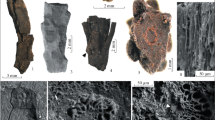Abstract
Polyxylic columnar stems covered by persistent leaf bases and found in sediments assignable to the Upper Cretaceous of Bajo de Santa Rosa, Río Negro Province, Argentina, are described as two new generic entities in the Cycadales. Anatomical characters are the basis for their being assigned to the Encephalartoideae of the Zamiaceae.Brunoa santarrosensis gen. et sp. nov. is characterized by the presence of polyxyly, cone domes, mucilage cavities, and uniseriate to triseriate araucaroid, scalariform, or bordered intervascular pitting.Worsdellia bonettiae gen. et sp. nov. has polyxyly, anastomosing medullary vascular bundles, centripetal xylem, mucilage canals, and concentric extraxylary bundles. Some characters (polyxyly, medullary vascular bundles, and cone domes) were used to determine the systematic position, while other characters (mucilage reservoirs and centripetal xylem) were used to establish the relationship between polyxylic and monoxylic forms.
Similar content being viewed by others
Literature Cited
Andreis, R. 1996. The Cretaceous-Tertiary boundary around the Somuncurá Massif (northern Patagonia, Argentina): Considerations about the Los Alamitos and Allen Formations. News of the First Annual Conference of IGCP Project 381 (SAMCI), Salvador, Bahia, Brazil 5: 12–14.
—E. Ancibor, S. Archangelsky, A. E. Artabe, J. Bonaparte &J. Genise. 1991. Asociación de vegetales y animales del Cretácico tardio del norte de la Patagonia. Ameghiniana 28(1–2): 201–202.
Archangelsky, S. &D. Brett. 1963. Studies on Triassic fossil plants from Argentina, II.Michelilloa waltonii nov. gen. et sp. from the Ischigualasto Formation. Ann. Bot. 27: 147–154.
Artabe, A. E. 2001. The fossil Cycadales of Argentina. Savitriana 1: 1–26.
—D. W. Stevenson. 1999. Fossil Cycadales of Argentina. Bot. Rev. 65: 219–238.
-& A. B. Zamuner. 1999. A new cycad stem from the Upper Cretaceous of Patagonia, Argentina. Boletim do 5° Simposio o Cretáceo do Brasil, UNESP, Campus de Rio Claro/SP: 309–313.
Ash, S. 1985. A short thick cycad stem from the Upper Triassic of Petrified Forest National Park, Arizona and vicinity. Museum of Northern Arizona Bulletin 54: 17–32.
Cantrill D. J. 2000. A petrified cycad trunk from the Late Cretaceous of the Larsen Basin, Antarctica. Alcheringa 24: 307–318.
Chamberlain, C. J. 1909.Dioon spinulosum. Bot. Gaz. 48: 401–413.
—. 1911. The adult cycad trunk. Bot. Gaz. 52: 81–104.
Crane, P. R. 1988. Major clades and relationships in “higher” gymnosperms. Pp. 218–272in C. B. Beck (ed.), Origin and evolution of gymnosperms. Columbia Univ. Press, New York.
Dorety, H. 1909. The extrafascicular cambium ofCeratozamia. Bot. Gaz. 47: 150–152.
Gould, R. E. 1971.Lyssoxylon grigsbyi, a cycad trunk from the Upper Triassic of Arizona and New Mexico. Amer. J. Bot. 58: 239–248.
Greguss, P. 1968. Xylotomy of the living cycads, with a description of their leaves and epidermis. Akademiai Kiadó, Budapest.
Hill, K. D., D. W. Stevenson &R. Osborne. 2004. The world list of cycads. Bot. Rev. 70(2): 274–298.
Jain, K. P. 1962.Fascivarioxylon mehtae gen. et sp. nov., a new petrified cycadean wood from the Rajmahal Hills, Bihar, India. The Palaeobotanist 11: 138–143.
Johnson, L. A. S. 1959. The families of cycads and the Zamiaceae of Australia. Proc. Linn. Soc. N. S. W. 84: 64–117.
Lutz, A. & A. Crisafulli. 1998. Lenos de Cycadales de la Formación La Temera (Triásico Superior), Chile. Resümenes 7° Congreso Argentino de Paleontologia y Bioestratigrafía, Bahía Bianca: 9.
Mamay, S. H. 1969. Cycads—Fossil evidence of Late Paleozoic origin. Science 164 (3877): 295–296.
— 1976. Paleozoic origin of the cycads. U.S. Geological Survey Professional Paper 934: 1–48.
Nishida, H., M. Nishida &K. Tanaka. 1991. Petrified plants from the Cretaceous of the Kwanto Mountains, central Japan, [II. A polyxylic cycadean trunk,Sanchucycas gigantea gen et sp. nov. Bot. Mag. (Tokyo) 104: 191–205.
Norstog, K. &T. Nicholls. 1997. The biology of the cycads. Cornell Univ. Press, Ithaca, NY.
Petriella, B. 1969.Menucoa cazaui nov. gen. et sp., tronco petrificado de Cycadales, Provincia de Rio Negro, Argentina. Ameghiniana 6(4): 291–302.
— 1972. Estudio de las maderas petrificadas del Terciario inferior del área central de Chubut (Cerro Bororó). Revista del Museo de La Plata (n.s.), sección Paleontología 6: 159–254.
— &J. V. Crisci. 1975. Estudios numéricos en Cycadales, I. Cycadales actuales: Sistemática. Boletfn Sociedad Argentina de Botánica 16(3): 231–247.
—. 1979. Estudios numéricos en Cycadales, II. Cycadales actuales: Simulación de érboles filogenéticos. Obra del Centenario del Museo de La Plata 3: 151–159.
Smoot, E. L., T. N. Taylor &T. Delevoryas. 1985. Structurally preserved fossil plants from Antarctica, I.Antarcticycas, gen. nov., a Triassic cycad stem from the Beardmore Glacier area. Amer. J. Bot. 72: 1410–1423.
Stevenson, D. W.. 1988. Strobilar ontogeny in the Cycadales. Pp. 205–244in P. Leins, S. Tucker & P. Endress (eds.), Aspects of floral development. J. Cramer, Berlin.
— 1990. Morphology and systematics of the Cycadales. Mem. New York Bot. Gard. 57: 8–55.
— 1992. A formal classification of the extant cycads. Brittonia 44: 220–223.
Taylor, T. N. 1969. Cycads: Fossil evidence of the Upper Pennsylvanian. Science 164: 294–295.
Worsdell, W. C. 1896. The anatomy of the stem ofMacrozamia compared with that of other genera of Cycadaceae. Ann. Bot. 10(40): 601–620.
— 1901. Contributions to the comparative anatomy of the Cycadaceae. Trans. Linn. Soc. London, ser. 2(6): 109–121.
— 1906. The structure and origin of the Cycadaceae. Ann. Bot. 20: 129–155.
Zamuner, A. B. 1992. Estudio de una tafoflora de la localidad tipo de la Formación Ischigualasto (Netotrias), Provincia de San Juan. Tesis inédita N 483. Facultad de Ciencias Naturales y Museo de La Plata, U.N.L.P.
Zhu, J.-N. &Du, X.-M. 1981. A new cycadPrimocycas chilensis gen. et sp. nov. from the Lower Permian in Shanxi, China and its significance. Acta Botanica Sinica 23: 401–404.
Author information
Authors and Affiliations
Rights and permissions
About this article
Cite this article
Artabe, A.E., Zamuner, A.B. & Stevenson, D.W. Two new petrified cycad stems,Brunoa gen. nov. andWorsdellia gen. nov., from the Cretaceous of Patagonia (Bajo de Santa Rosa, Río Negro Province), Argentina. Bot. Rev 70, 121–133 (2004). https://doi.org/10.1663/0006-8101(2004)070[0121:TNPCSB]2.0.CO;2
Issue Date:
DOI: https://doi.org/10.1663/0006-8101(2004)070[0121:TNPCSB]2.0.CO;2




